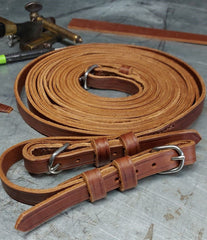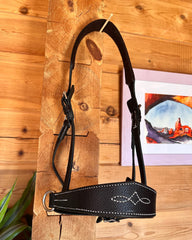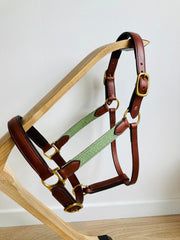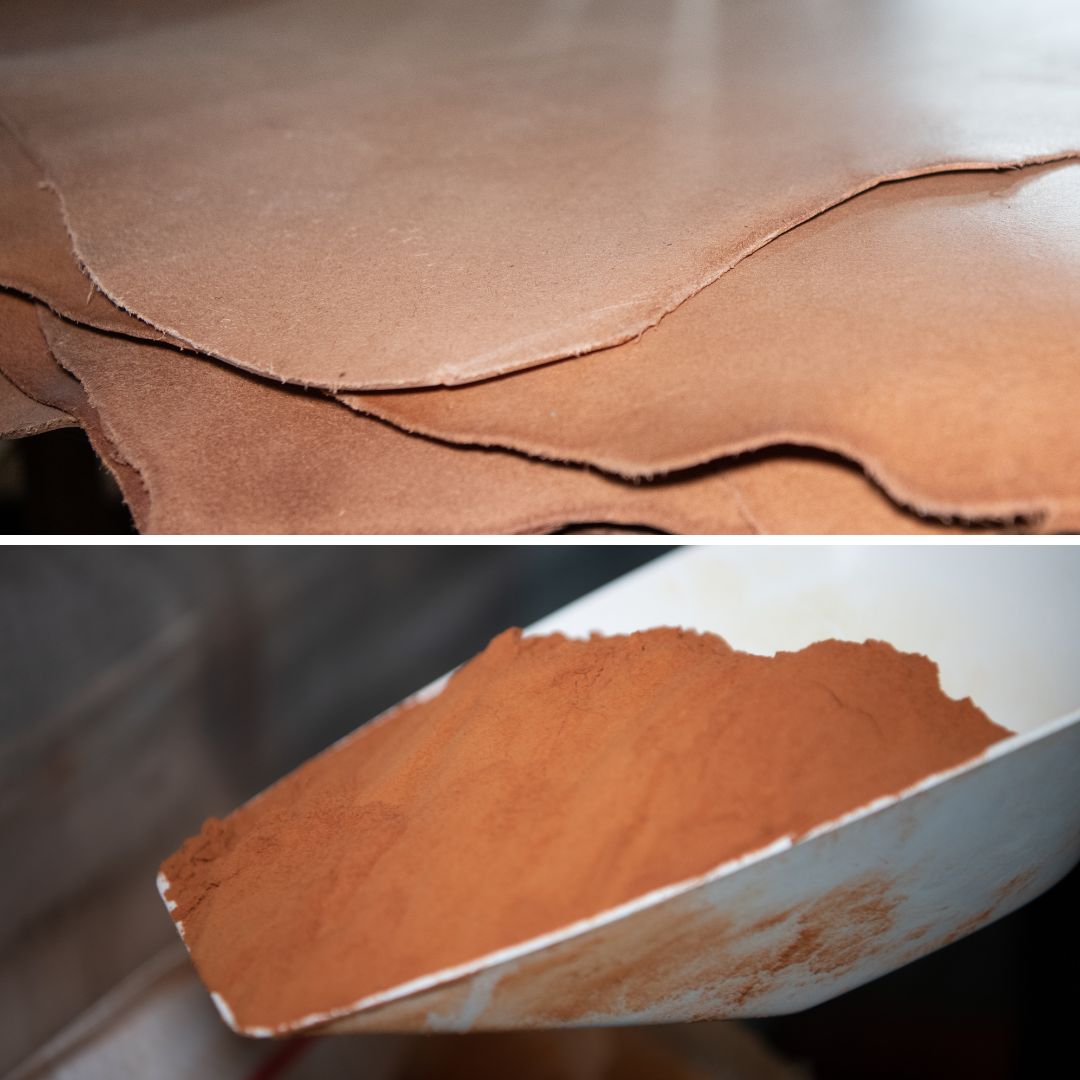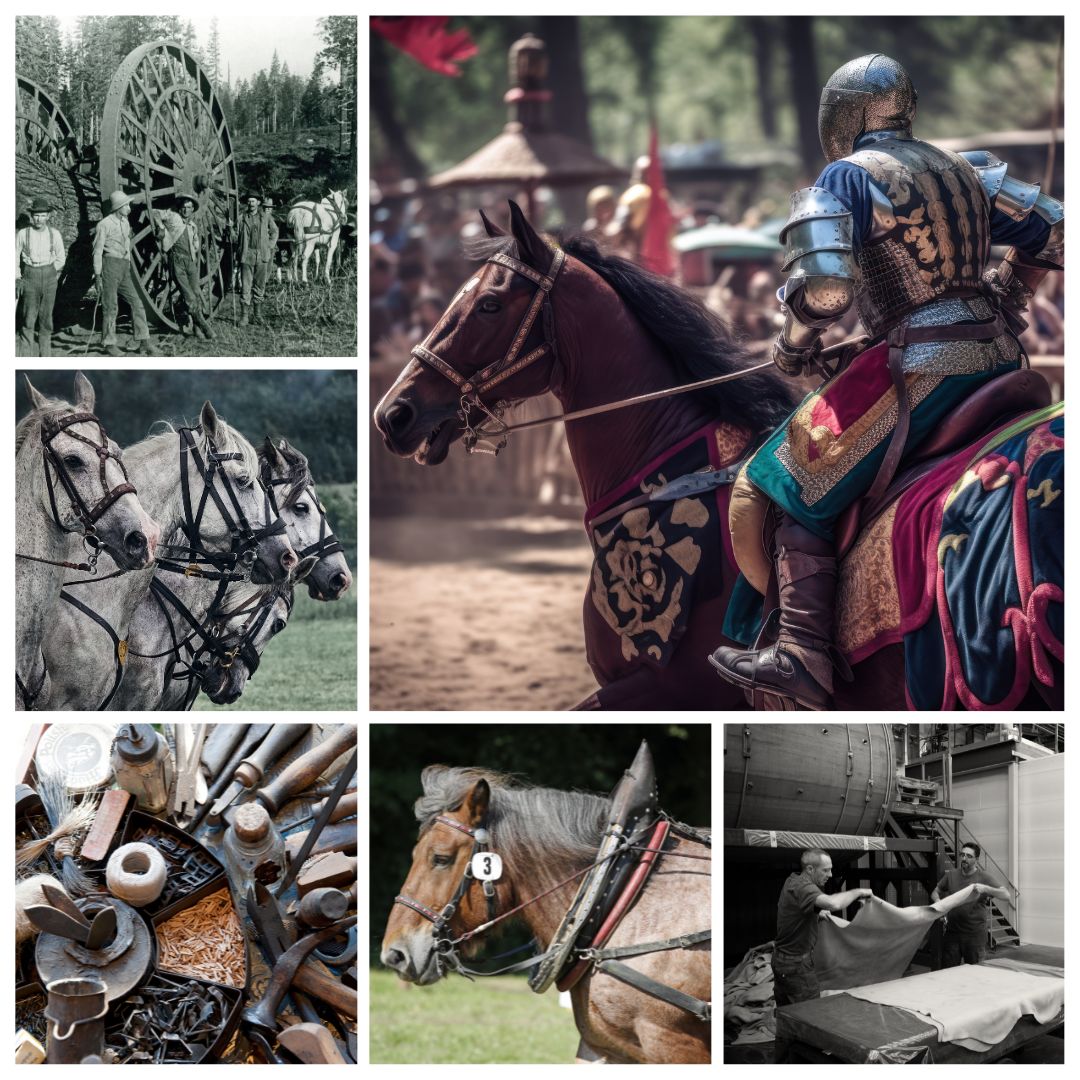
When it comes to riding, one of the most important steps is theharnessing. Horse tack is the set of parts used to equip the domestic horse for work, sport or leisure, enabling the rider to control the horse safely and comfortably. In this article, we'll explore some of the key elements of horse harnessing, such as the bridle, snaffle, hackamore, side-pull and driving harness, as well as the halter, the equipment used when the horse is not being ridden.
Photo: Realization by Sellerie Epoquia
Bridle and net: understanding the differences and their importance
When venturing into the world of horseback riding, it's essential to understand the various pieces of equipment needed to control your horse. Two of the most important pieces of equipment are the net and bridle. We explain the differences and their importance in riding and communicating with the horse.
The net or bridle
The bridle is one of the most common pieces of equestrian equipment. It consists of a bit, uprights, reins and browband. The net is mainly used to control the horse's direction and to transmit subtle signals from the rider's hand to the horse's mouth. It enables the horse to be steered, slowed down and stopped using the reins by exerting pressure on the bit.
Photo: Realization by Sellerie Bourrellerie Laetitia
The bridle
The bridle is a more complex piece of equipment that consists of a net, but with the addition of several other important parts. It includes a bit, uprights, reins, upright loops, noseband and often a browband. The bridle is used for more precise control of the horse than the net. It offers a wider range of adjustment options for the rider, enabling better adjustment to the horse's needs.
Photo: Realization by MLM Sellier
The choice between net and bridle depends on the horse's specific needs, the rider's level of experience and the riding discipline. The bridle is commonly used in dressage for precise control, while the snet is more common in disciplines such as show jumping.
What components make up the bridle and the net?
The headpiece
The headpiece is an integral part of the bridle and plays an essential role in the horse's comfort and safety. It is the part that passes over the horse's head, just behind the ears. It attaches to the top of the bridle and helps keep the bridle in place on the horse's head. The headpiece distributes the pressure exerted by the bridle evenly over the horse's head, avoiding excessive pressure points that could cause discomfort or injury. Some headgear models are padded for added comfort. The headpiece is a standard component of most bridles used in equestrian sports, whether in dressage, show jumping, western or other disciplines.
Photo: Realization by Cabon Sellier
The browband
The browband is located on the front of the horse's head, just above the eyes. Like the headpiece, the browband helps keep the bridle in place on the horse's head; and it distributes the pressure exerted by the bridle evenly over the horse's head, avoiding excessive pressure points that could cause discomfort or injury.
The browband can also be used for aesthetic purposes to embellish the bridle or snaffle, particularly in the world of competitive riding.
Photo: Realization by Poons and Paws Sàrl
The cheekpieses
The cheekpieses, also known as "sheaths", are the lateral parts of the bridle that run from the browband to the bit on either side of the horse's head. They form a loop around the horse's head and help hold the bridle in place. They help secure the bit in the horse's mouth, which is essential for the rider to exercise effective control. They also act as a support for the reins.
Photo: Realization by Bourrellerie de Chloé
The bit
The bit is generally made of metal, most often stainless steel, copper, aluminum or composite materials. They are made up of the cheek pieces, the lateral parts that come into contact with the corners of the horse's mouth; the barrel, the central part that rests in the horse's mouth, which can be straight, curved or double-jointed; and the cheek rings, the lateral parts to which the reins are attached.
The bit enables the rider to control the horse's direction and speed. There are many different types of bits (single or double bit, straight barrel bit, Pelham bit, Western bit, etc.), each with a specific design and function.
The noseband
The noseband is designed to fit around the horse's muzzle, under the nostrils. It is attached to the bridle and lies just below the browband. The noseband holds the bridle in place, helping to control the horse's jaw and transmit signals from the bridle bit when the rider applies pressure to the reins. It can also help stabilize the horse's mouth, which is particularly important in certain equestrian disciplines, such as dressage. There are several types of noseband: French noseband (or cavesson noseband), combination noseband, Mexican noseband, hackamore noseband.
Photo: Realization bySambre Créations
The troathatch
The troathatch is a part of the tack used for riding, particularly in the context of western tack. The troathatch is a strap or webbing that passes under the horse's throat, connecting the 2 sides of the bridle.
The reins
Reins are an integral part of the bridle and are held by the rider to exert control over the horse. The reins enable the rider to communicate instructions to the horse and direct his mount. They are attached to the bit or hackamore. There are different types of reins: one-handed, two-handed, long reins, etc.
Photo: Realization byBourrellerie Collin
What are a hackamore and a side-pull? What are the differences between these 2 pieces of harness?
The side-pull and the hackamore are two types of equestrian equipment that enable riding without using a bit in the horse's mouth. Although they have some similarities, they also have important differences in terms of design and operation. Here are the main differences between the side-pull and the hackamore:
The side-pull
A side-pull consists mainly of a nose band that rests on the horse's nose, and reins attached to this band. It is relatively simple in design. The side-pull works by exerting pressure on the horse's nose when the rider pulls on the reins. The pressure on the nose is mainly vertical, allowing the rider to communicate instructions to the horse using gentle or firmer pressure on the reins.
Side-pulls are commonly used in disciplines such as western riding, ethological riding and other leisure disciplines where light, direct communication with the horse is preferred.
The most common types of side-pull are :
- Basic side-pull: This consists of a single nose band and reins attached directly to this band. This is the simplest form of side-pull.
- Side-pull with chin strap: This side-pull has an additional chin strap that exerts pressure on the horse's chin for better control.
- Ethological side-pull: Designed for more subtle communication with the horse, it can have special attachments to allow independent lateral movements of the reins.
Photo: realization by Epycuir
The Hackamore
A hackamore is designed with a more complex mechanism than the side-pull. It usually consists of a nose band that rests on the horse's nose, a top part called a "hump" that exerts pressure on the nose when the rider pulls on the reins, and reins attached to the hump.
The hackamore works by exerting pressure on the horse's nose, but it can also exert lateral and more precise pressure depending on the design. The pressure is generally more direct than that of a side-pull, enabling more precise communication with the horse.
Hackamores are often used in disciplines such as western dressage, working cattle riding and other disciplines where precise control is required.
The main difference between the side-pull and the hackamore lies in the complexity of their design and the way they exert pressure on the horse's nose. The side-pull is simpler and exerts mainly vertical pressure, while the hackamore is more complex and can exert lateral and more precise pressure.
There are various types of hackamore, the most common of which are :
- Soft-nosed hackamore with a wide, padded noseband, often used for horses sensitive to pressure in the mouth.
- Hard-nosed Hackamore with a stiffer nose band, suitable for more experienced horses.
- Mechanical hackamore, with levers to increase the pressure exerted on the horse's nose, often reserved for experienced riders.
The side pull and hackamore are sometimes chosen for horses with mouth problems or who are reluctant to accept a bit, or simply for riders who prefer a softer alternative.
Photo: Realization by Mcuirs créations
Driving harness
The importance of a good harness
Harnessing, or driving a horse harnessed to a carriage, wagon or horse-drawn carriage, is an ancient and elegant activity that requires the right equipment to ensure the horse's safety and comfort. An essential part of this equipment is the harness. Unlike a conventional riding harness, a driving harness is designed to distribute tension and pressure appropriately over the horse's body, enabling it to pull the vehicle safely.
Photo: realization of Cannelle Collet Bourrellerie & Maréchalerie
Harness components
The collar is the part of the harness that rests on the horse's shoulders and is attached to the vehicle. It's crucial that the collar fits snugly to avoid excessive rubbing or pressure on the horse's neck.
The breast band is the part of the harness that goes around the horse's chest to hold the collar in place. It's usually padded for added comfort.
Guides are the straps that run around the horse's body to secure the harness in place. They must be adjusted so that they are neither too tight nor too loose.
The lines are the straps that run under the horse's tail to hold the harness in place. They also prevent the harness from sliding back.
What is a halter?
A halter is a piece of equestrian equipment used to contain and handle a horse when it is not being ridden. It generally consists of leather strapsnylon, rope or similar materials, and consists of different parts that surround the horse's head. The halter is often used to bring a horse from the paddock to the stable, to groom it, to load it into a van or for any other handling outside of riding.
Photo: Realization by Sellerie Gaby
A halter consists of the following components: a headpiece, a noseband, and neck and nose straps. Some halter versions have additional nose straps that cross under the noseband for greater stability.
The halter is used for a variety of activities with horses, including :
- Moving: often used to move the horse from the paddock to the stable or vice versa.
- Grooming: keeps the horse still during grooming, brushing and other treatments.
- Transport: Used to load the horse safely into a van or trailer.
- Restraint: It can be used to restrain a horse in a situation where extra control is needed, such as during a veterinary examination or medical treatment.
There are many different types of halter, including leather, nylon, rope and even ethological halters designed for more subtle communication with the horse.
As with all leather equestrian equipment, it is important to keep your tack in good condition by carrying out regular maintenance to prevent the build-up of dirt and moisture, which can cause premature wear.








